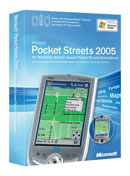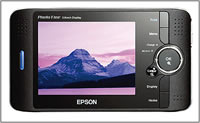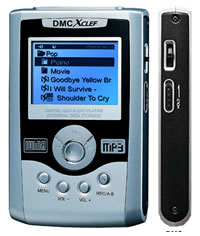 Microsoft recently announced Pocket Streets 2005 as a stand-alone product, although it still remains a component of their Streets and Trips 2005 package. There are two separate stand-alone versions ¯ Pocket Streets 2005 for Windows Mobile-based Pocket PCs, and Pocket Streets 2005 for Windows Mobile-based Smartphones.
Microsoft recently announced Pocket Streets 2005 as a stand-alone product, although it still remains a component of their Streets and Trips 2005 package. There are two separate stand-alone versions ¯ Pocket Streets 2005 for Windows Mobile-based Pocket PCs, and Pocket Streets 2005 for Windows Mobile-based Smartphones.
If you own a Smartphone, you can toss away the compass since the Smartphone version now has GPS support. Previous versions of Pocket Streets only had GPS functionality in the Pocket PC version. If you are looking for routing and driving directions though you will still need to consult Microsoft Streets & Trips or Microsoft MapPoint.
You can generate directions and maps for Pocket Streets using the 2004 or later versions of MapPoint, Microsoft Streets & Trips, and AutoRoute, or you can download Microsoft’s maps of major cities. Pocket Streets 2005 includes more than 300 maps of North America and more than 275 maps of Western Europe, as well as Microsoft ActiveSync 3.7. New maps are available for Australia, Brazil, and Greece, but these will only be compatible with Pocket Streets 2005.
This is an ideal companion for any tourist visiting a city for the first time. You can locate the nearest ATM or service garage, in fact Pocket Streets has an extensive in-built list of bank ATMs and public transportation sites. You can customize maps with personal points of interest, and a new measurement scale feature is expected to determine the distance between locations more accurately.
Two useful features will help the more absent-minded traveller. Pocket Streets 2005 opens with the most recently used map already loaded, and you can search for destinations and addresses by using only partial names.
Pocket Streets is currently only available in English, but you can download maps that are in any language. It will sell for an estimated retail price of $24.95 (~€19.63).
 Designed as a replacement for Epson’s P-1000, the imaginatively named P-2000 has higher capacity storage, a faster interface, two memory card slots and the ability to view, store and playback photos, videos and music. If you are still nostalgic about the black and white photos taken in the back garden with the Brownie camera, just think of the multi-sensorial memories your kids will have.
Designed as a replacement for Epson’s P-1000, the imaginatively named P-2000 has higher capacity storage, a faster interface, two memory card slots and the ability to view, store and playback photos, videos and music. If you are still nostalgic about the black and white photos taken in the back garden with the Brownie camera, just think of the multi-sensorial memories your kids will have. Just when you were find it tough to find enough music to fill your 40Gb iPod, Digital Mind comes along with the DMC Xclef 500 portable MP3 music players. Christened “big brother” it has the largest available storage space of any portable music player on the market. With a price tag of $449.00 (~€355), this bouncing 100Gb baby is capable of holding more than 25,000 music files, so now all you need is the time to listen to them – close to two months of 24 hours a day listen.
Just when you were find it tough to find enough music to fill your 40Gb iPod, Digital Mind comes along with the DMC Xclef 500 portable MP3 music players. Christened “big brother” it has the largest available storage space of any portable music player on the market. With a price tag of $449.00 (~€355), this bouncing 100Gb baby is capable of holding more than 25,000 music files, so now all you need is the time to listen to them – close to two months of 24 hours a day listen.